BobD1001
Hazard to Others
  
Posts: 182
Registered: 29-3-2013
Member Is Offline
Mood: No Mood
|
|
Plasti Dip to Make Safety Glass Bottles
I recently have been looking around for some bottles to safely store concentrated nitric. I came across some 16oz glass amber bottles with a PTFE
Lined cap, non safety coated for about $24 (12 bottles). Soon after I found the same amber bottle with a PTFE lined cap from the same company, with a
Plastisol safety coating on the outside for $71 (12 bottles).
Obviously that price difference seems a bit outrageous considering the only difference between the bottles is the Plastisol coating. My thought is to
purchase the dozen less expensive bottles, and dip them up to their neck in clear Plasti Dip to act as a safety coating in case an accident ever were
to happen. According to Plasti Dip's website:
"Plasti Dip® protective coating has excellent resistance to acids, alkaline, and most common household chemicals. However, it is best to test this
before going ahead with your application. Plasti Dip® does have limited resistance to petroleum based products. "
So while I'm not placing any bet that it would hold up to concentrated nitric for long durations, it would likely be sufficient for those precious few
seconds needed to re-contain the broken vessel. Plus the Plasti Dip's absorption of mechanical forces would potentially help prevent the glass from
breaking in the first place.
Any thoughts gentlemen?
Thanks,
Bob
|
|
|
watson.fawkes
International Hazard
    
Posts: 2793
Registered: 16-8-2008
Member Is Offline
Mood: No Mood
|
|
Buy a small container of your desired plastic coating. Test it in nitric acid.
|
|
|
Dr.Bob
International Hazard
    
Posts: 2734
Registered: 26-1-2011
Location: USA - NC
Member Is Offline
Mood: No Mood
|
|
Another simple solution is to just put the glass bottle inside of a thick plastic container for storage and handling. You could cut the top off of a
larger plastic bottle, container, or even use a metal can as secondary containment. I might have a couple of plastic coated bottles left also, if
you just want to buy one or two, rather than a whole case. But I just sold a bunch of the exact coated bottles that you describe, and that price is
not that bad. The shipping is almost as bad as the cost of the bottles in many cases, as they are heavy.
|
|
|
neuman
Harmless

Posts: 1
Registered: 25-3-2013
Member Is Offline
Mood: No Mood
|
|
Plasti-dip comes off pretty easy on metal hand tools, you'd have to dip the item like 30-50 times in my opinion, I think I will try it and see.
|
|
|
BobD1001
Hazard to Others
  
Posts: 182
Registered: 29-3-2013
Member Is Offline
Mood: No Mood
|
|
Dr. Bob I will buy the couple plastic coated amber bottles you have left over. Just to verify, they have PTFE lining on the caps?
If you could PM me the cost and paypal email address to send the $ to ill send it asap.
|
|
|
BobD1001
Hazard to Others
  
Posts: 182
Registered: 29-3-2013
Member Is Offline
Mood: No Mood
|
|
Well over the past couple days I safety coated about 4 bottles with two different types of aerosolized rubber coatings. The first was Home Armor
"clear" rubberized coating from Home Depot. The second was Plasti Dip Clear. The Home Armor Ended up creating a horribly sticky air-bubble including
mess. The Plasti Dip was highly favorable, and looks/performs much like the Schott Duran bottles I have. I will later be doing some destructive impact
tests to verify performance.
Here are some pictures of the process:
The Home Armor and Bottle to be coated
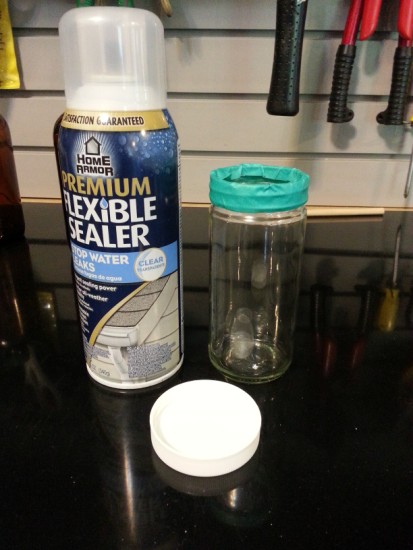
The Plasti Dip and the awaiting bottle
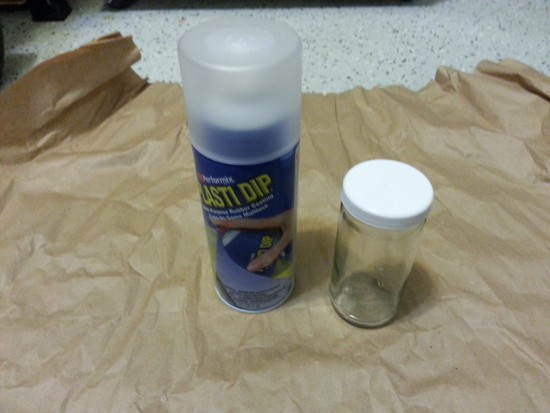
The process was overall stupidly simple. I just taped over the threads with some painters tape, making sure it was tight over the threads. Applied
several coats of the rubberized spray (the bottles were sprayed both upright (with a towel stuffed inside to prevent overspray from entering the
bottle) and upside down.
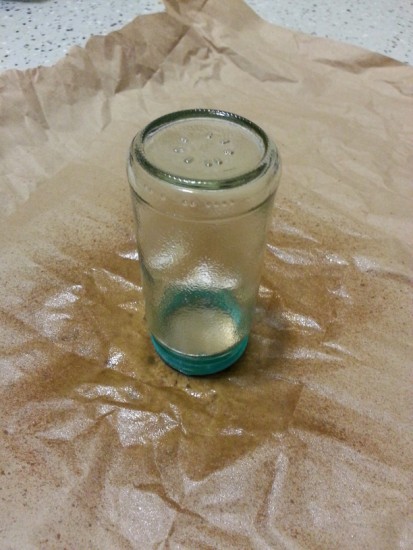
Then once cured for 24 hours, I took an exacto knife to the edge of the tape so that it wouldn't pull the safety coating off, then simply peeled it
away and was left with a clean safety bottle.
Here is a a comparison shot between the two coatings used:
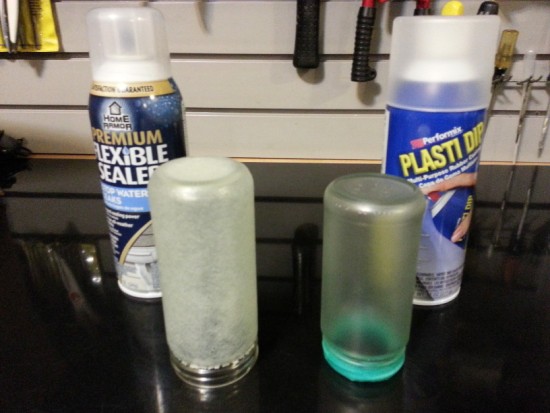
I actually ended up removing the Home Armor coating (damn was it stuck to that glass!) from the larger bottle and Plasti Dipped it.
Here's a shot next to a Schott Duran bottle. The resemblence is uncanny:
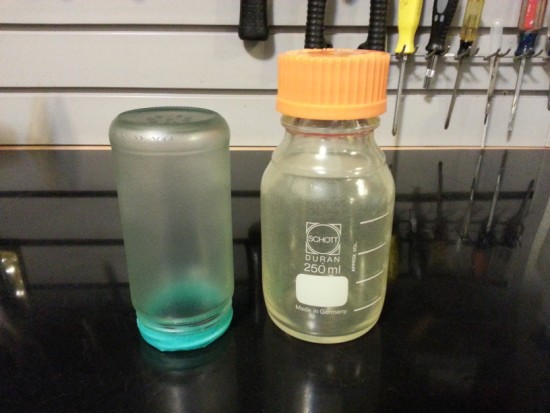
And the final results looking pretty, and grip extremely well:
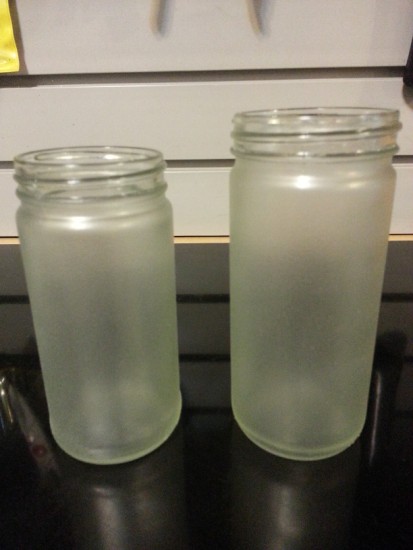
[Edited on 8-5-2013 by BobD1001]
[Edited on 8-5-2013 by BobD1001]
|
|
|
Arsole
Hazard to Self
 
Posts: 52
Registered: 21-1-2012
Location: USA
Member Is Offline
Mood: Sleepy
|
|
I know you are probably fairly attached to those bottles after all that work and they do look very good. That being said you need to crack one up and
test its ability to hold together otherwise it just looks pretty. 
Thoughts, like fleas, jump from man to man, but they don't bite everybody.
-Stanisław Jerzy Lec
|
|
|
thewanderer
Harmless

Posts: 8
Registered: 22-2-2013
Member Is Offline
Mood: No Mood
|
|
Nice idea with the Plasti Dip, but does it seem like it would scratch off fairly easy?
It would be interesting to try an impact shock on one and then also try a thermal shock on another. The results may end up [somewhat] different.
|
|
|
BobD1001
Hazard to Others
  
Posts: 182
Registered: 29-3-2013
Member Is Offline
Mood: No Mood
|
|
Already have some bottles ready for destructive testing!
The coating is quite resistant to scratches and light impact, much more-so than i had imagined!
|
|
|
Oscilllator
National Hazard
   
Posts: 659
Registered: 8-10-2012
Location: The aqueous layer
Member Is Offline
Mood: No Mood
|
|
I dont see why the coatings need to be very resistant to chemicals. They dont come in contact with them in day-to-day use, and if the bottle does
break pretty much any plastic will hold up for long enough for you to put it somewhere safe. With that in mind, just wrap the bottles in duct tape!
|
|
|
confused
Hazard to Others
  
Posts: 244
Registered: 17-3-2013
Location: Singapore
Member Is Offline
Mood: tired
|
|
would the plastidip obscure any labels if they were sandwitched between the glass and plastidip layer?
|
|
|
Fantasma4500
International Hazard
    
Posts: 1681
Registered: 12-12-2012
Location: Dysrope (aka europe)
Member Is Offline
Mood: dangerously practical
|
|
well for nitric acid you are so lucky that aluminium is pretty much inert to it (:
it will be cheaper im very sure of, but it will look more rubbish..
in short: wrap the bottles in aluminium foil
you can perhaps tape the aluminium foil so it will hold up very well also.. perhaps get an aluminium container of some sort (bucket?) 100% sure that
shouldnt be too hard to get a hold of..
if you want it to look abit better you could perhaps contact a smith to make some fitting cylindrical tubes of aluminium
|
|
|
BobD1001
Hazard to Others
  
Posts: 182
Registered: 29-3-2013
Member Is Offline
Mood: No Mood
|
|
This isn't simply for nitric storage anymore. I acquired some excellent plastisol coated safety and ptfe lined cap bottles form Dr. Bob and am now
storing my nitric in one of the bottles received from him. However, I feel that many other chemicals should be stored in a safety coated bottle. For
instance, my potassium permanganate will be stored within one of these bottles now. I don't even want to imagine cleaning up a permanganate powder
spill.
I also plan to test the chemical resistance of the plasti dip. I will test in nitric, which I think it will hold up to for some time. Sulfuric, which
im sure will carbonize it after some time. And HCl as well, which I believe wont compromise its integrity for some time... However these are all just
my hypothesis. Testing will prove them right or wrong.
|
|
|
Arsole
Hazard to Self
 
Posts: 52
Registered: 21-1-2012
Location: USA
Member Is Offline
Mood: Sleepy
|
|
Speaking of messes I once dropped a glass bottle with about 500g of MnO2 on the floor while moving some things from one room to another. The bottle
shattered and the stuff went everywhere, freaking impossible to clean from carpet and untreated wood. Wish the bottle would have been coated. now when
I transfer chems they are in at least a rubber tote not 7 in one hand lol.
Thoughts, like fleas, jump from man to man, but they don't bite everybody.
-Stanisław Jerzy Lec
|
|
|
Finnnicus
Hazard to Others
  
Posts: 342
Registered: 22-3-2013
Member Is Offline
|
|
I have had such a bad experience with impure MnO2/C mixture. Ugh it was all over.... Even the rain won't wash it away! These bottles would be a
lifesaver!
|
|
|
cyanureeves
National Hazard
   
Posts: 744
Registered: 29-8-2010
Location: Mars
Member Is Offline
Mood: No Mood
|
|
i got some 1"wide teflon tape from ebay about three weeks ago to spread over the mouth of a bottle holding nitric acid and the ordinary bottle cap has
held up so far.
[Edited on 5-10-2013 by cyanureeves]
|
|
|
Fantasma4500
International Hazard
    
Posts: 1681
Registered: 12-12-2012
Location: Dysrope (aka europe)
Member Is Offline
Mood: dangerously practical
|
|
i dont get it.. why do you guys want to have powders that doesnt really interfere or react with plastic as in plastic bags or containers in glass
containers?
anyhow for MnO2 NaHSO3 or HCl should work
|
|
|
Arsole
Hazard to Self
 
Posts: 52
Registered: 21-1-2012
Location: USA
Member Is Offline
Mood: Sleepy
|
|
Q: "i dont get it.. why do you guys want to have powders that doesnt really interfere or react with plastic as in plastic bags or containers in glass
containers?
anyhow for MnO2 NaHSO3 or HCl should work"
For me it is for a few reasons,
1) Consistency, all of my reagents are in clear Boston round bottles from a store called Specialty Bottle, I ordered a bunch at one time and the
prices are very cheap. I also ordered a thin piece of Teflon sheet off eBay and replaced the cardboard inserts in the caps with circular Teflon
cutouts. I also wrap the threads with Teflon tape if they will not be opened for awhile. This method has, so far, worked very well for me.
2) With glass I do not have to worry about compatibility at all, none. As long as I am not storing super strong aqueous bases or HF (Which I do not)
there are no issues with compatibility (especially solvents).
3) Aesthetic, a row of glass bottles with nice labels and consistent sizes looks a lot better than miscellaneous plastic bottles everywhere (in my
opinion).
As far as the rubberized coating goes I would want it simply to hold the glass together if the bottle cracked. Sulfuric acid wrecks a ton of things
and if the bottle broke but held together you could save yourself a mess and having to buy a new pair of shoes.  This would give you the inertness of glass with more of the safety of plastic. This would give you the inertness of glass with more of the safety of plastic.
[Edited on 5-11-2013 by Arsole]
Thoughts, like fleas, jump from man to man, but they don't bite everybody.
-Stanisław Jerzy Lec
|
|
|